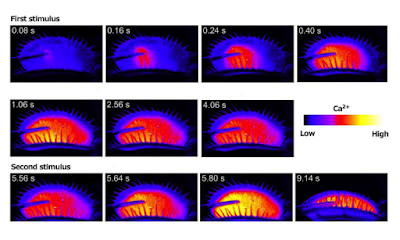Posted by Jordan Berry
Recently, as reported in the Newy York Times novel neurosurgery was performed that gave new life without seizures,
epilepsy, and chronic anorexia. The patient? Cronutt, a 7-year old sea lion.
Figure 1: A picture of Cronutt after surgery
Figure 2: The two pastries for which Cronutt is named after, the croissant and the donut
Climate change has had many deleterious effects for environments and for people, but
many do not consider the effect on aquatic life. Climate change has lead to the prominence and
proliferation of algal blooms, algae that uncontrollably grow and distribute domoic acid to
shellfish that sea lions, like Cronutt, eat to survive. This poison, is for one, a neurotoxin that
have recently caused a new form of climate change induced epilepsy called amnesic shellfish
poisoning (ASP) in animals like sea lions, sea otters, and humans.
Figure 3: Domoic Acid
Unfortunately, due to the novelty of this disease, there currently is no treatments
available. According to the Washington State Department of Health, for humans they are
typically put on life support until either the toxin passes through their system or they die. For sea
lions without a complex medical system like humans, they tend to suffer terrible deaths by
drowning while having a seizure underwater. Typical epileptic treatments like Valium, steroids,
and phenobarbital fail, so a new treatment was devised where three neurosurgeons from USCF
replaced hippocampal neurons in Cronutt’s brain using embryonic pig brain cells. This surgery,
according to the neurosurgeons and his veterinarian caretakers, seems to have been successful
at first glance. Only time will tell if this success sticks.
(a) (b)
(c)
Figure 4: The typical seizure medications(a)Diazepam (Valium), (b)Prednisone
(typically labeled steroids), and (c)Phenobarbital
This article, although not chemophobic, gives negative connotations to chemistry. It does
not present chemists as aloof or indiscriminate to their waste, but it does present those who use
their inventions in this way. It presents the chemical medical treatments given the Cronutt as
insufficient and the chemical that is produced as a toxin a direct byproduct of human activity.
This article only prevents chemophobia by mentioning the specific names of the chemicals as to
prevent a generalization of all industrial chemicals as a cause of this. It does not perpetuate or
challenge the stereotypes of chemists since this story is not about chemists but the chemicals
themselves. It does argue that there needs to be more attention placed on our oceans, but does
not mention any specific actions chemists can take to alleviate these issues. As the story
concludes, one of the veterinarians mention, “Even if it doesn’t work, and there’s a chance it
won’t work, maybe Cronutt’s purpose is to educate that there are toxins in our water and our
ocean needs our attention.”





















